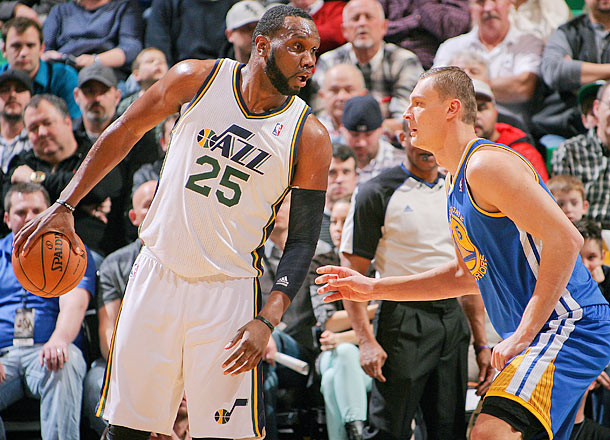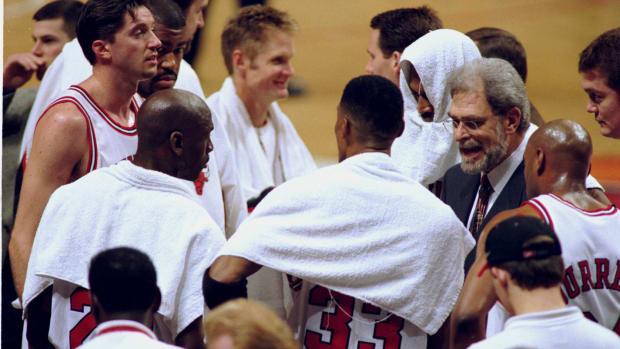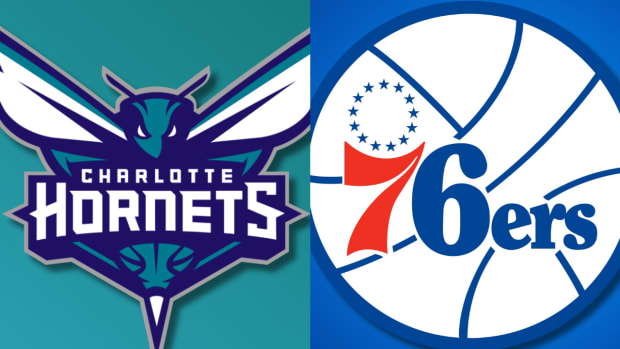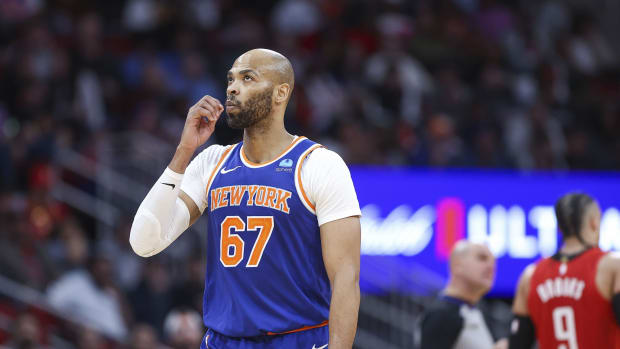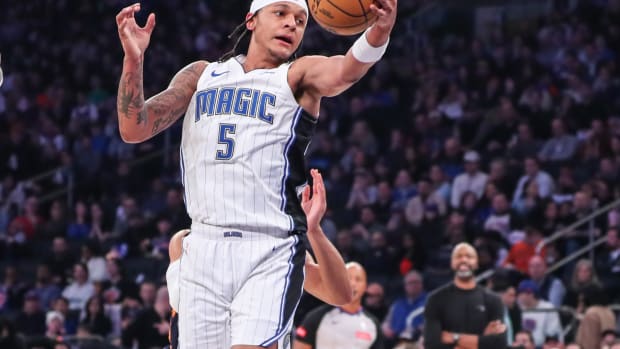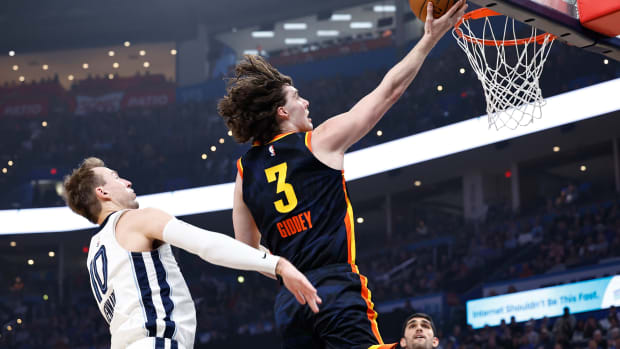NBA free agency: Buyer beware -- pay these five big money at your own risk
Al Jefferson (left) can score, but his offensive style and defensive shortcomings are problematic. (Gary Dineen/NBAE via Getty Images)
Teams with cap space often can be a danger to themselves. General managers, in their rush to improve their rosters (and in the sensible interest of seeing hard-earned cap space used), can wind up offering bloated contracts to deeply flawed players. Not every cap dollar needs to be saved for the perfect candidate, but some teams are so intent on using their space on some productive player that they often fall victim to paying big for the wrong one.
With free agency set to begin Monday at 12:01 a.m. ET, here are five players who could well benefit from such a mistake and be overcompensated based on team needs and the nature of the market. (Click here for five potential free-agent bargains.)
Al Jefferson
Productive big men tend to get their money, and Jefferson certainly has the raw numbers (17.8 points and 9.2 rebounds per game for Utah last season) to make claim to a sizable contract. (He just completed a five-year, $65 million deal.) But market dynamics shouldn't be confused for prudence; the fact that Jefferson, 28, is likely to get paid big doesn't mean he necessarily should, especially considering that his weaknesses are so glaring within a team concept.
The great majority of what Jefferson accomplishes on the court comes in the form of solitary acts. He clears out the left wing to face up his opponent; he plods to the low block to roll out an elaborate sequence of fakes; he attends to his defensive mark without offering much in the way of help. His is an isolated game by its very nature, only effective to a point. If given the ball too often, Jefferson's focused offense can render those around him a bit meaningless. If played too consistently, opponents will attack his slow feet and lacking defense in general, largely by playing with the expectation that his help will come late or not at all.
It doesn't take a deep dive into the film to see Jefferson's getting victimized in the pick-and-roll; his failure to cover the necessary space and angles leads to surface-level blunders and easy scores. Most opponents are already aware of this, judging by how often Jefferson was pulled in to pick-and-roll scenarios last season, and will look to attack him just as frequently regardless of whether he signs with a new team. A team with an elite back-line defender might be able to address some of the challenges that Jefferson's very presence creates, but his incorporation into any lineup requires a particular defensive infrastructure.
MAHONEY: Top free-agent ball handlers | Wings | Big men
It's difficult to construct an offense around a post player with neither outstanding scoring efficiency nor the ability to kick the ball out to open shooters on the weak side. Jefferson's capacity to score so readily in the half court makes him valuable, but the fact that he shoots 49.4 percent -- a good number on paper, but not exactly optimal because he doesn't get to the free-throw line much or shoot three-pointers as a high-usage player -- without contributing much to a greater offensive functioning makes him impractical for many teams. That's unlikely to stop a desperate suitor from giving Jefferson a lavish deal, but his inability to play effectively off others via pick-and-rolls and cuts could make such a contract instantly regrettable.
Jarrett Jack
The worry with Jack -- as with so many other "buyer beware" candidates -- is the idea of caveat to production. Jack averaged 15.7 points and 6.7 assists per 36 minutes in a reserve role last season, controlling the ball for the Warriors in crunch time and playing both guard spots. He played a prominent part in Golden State's success, often by creating for himself and hitting big shots at opportune moments.
Jack's knack for generating offense comes at a cost, though. Unseen passing lanes and unfulfilled alternatives are often bypassed in favor of a tough, contested shot. He finds angles into the lane but often fails to locate any teammate who isn't immediately available in his field of vision. He makes some nice drop-passes to big men around the rim, but otherwise Jack doesn't stray far from his immediate focus on the basket.
That's a manageable limitation in some cases and a disabling flaw in others -- a divide dependent largely on how a team chooses to use Jack. He's a fine supporting piece but could run his team into middling efficiency if the roster lacks suitable ball-handling alternatives. He works as a sixth man, in part because of his ability to fill gaps at either guard spot. But teams looking to pay market value for the 29-year-old Jack (who made $5.4 million last season) will likely want him to play an even bigger role, and for that inclination one will overpay for a productive individual who tends to dominate possessions at the expense of team offense.
Andrew Bynum
Almost every bit of information on Bynum's wobbly knees comes through the filter of his agent, who naturally paints a rather rosy picture of where his client stands in his rehab and allegedly impending return to the court. Bynum, 25, is the most obvious risk in this free-agent class after missing last season, but he brings a greater potential reward than most.
If healthy, Bynum is a definitive No. 3 on the free-agent big board, behind Dwight Howard and Chris Paul. But "if" is a dangerous word in his case, as we've now waited through a full season of arbitrary deadlines, public missteps and broken promises of Bynum's comeback. He's massive and talented, and his unique allure makes it easy to see an eager team committing too much to sign him. Most NBA executives are relatively risk averse, but productive big men tend to make even the most logical decision-makers lose their minds a bit, injury troubles be damned.
None of this is to imply that Bynum will get the max, or any deal approximating the kind of offers he might have received if healthy. But teams must also grapple with the urge to lock up Bynum on a long-term deal for below-market value, all without yet knowing if he can contribute regularly without posing so much of an injury risk. The temptation to nab a max-level player for a sub-max salary is understandable, and it could pay off big for a team willing to roll the dice. But if the troubles with Bynum's knees persist, that deal could well become a crippling load on a team's cap sheet without much hope for relief.
Tiago Splitter
Restricted free agency encourages ridiculous overspending. Rival suitors have little choice but to loft high-ball offers at their targets in the hope of outpricing the incumbent teams, who have matching rights. In Splitter's case, that means paying more than the Spurs -- who know the 28-year-old center's game better than anyone -- would be willing to spend. (San Antonio can make Splitter a restricted free agent by extending him a $4.9 million qualifying offer.) Deliberately outbidding one of the savviest organizations in the league should be a warning in itself, but Splitter's game should also make teams wary of tossing him an eight-figure salary based on their need for a big man.
Splitter does two very valuable things quite well: execute pick-and-rolls and guard them. Both warrant playing time and compensation, but Splitter also hasn't been tested as a high-usage player (he played a career-high 24.7 minutes per game last season) and offers inconsistent bits of offense. He's good for the odd post-up and doesn't waste opportunities to catch and finish, but Splitter isn't a big man who goes to great lengths to make himself available or assume a dominant role in the offense. He floats into open spaces and capitalizes. That's useful, but it isn't characteristically rewarded with the kind of contract that might be necessary to pull Splitter out of San Antonio.
Making an offer too rich for the Spurs to match would basically necessitate paying Splitter at a near-star clip, which could ultimately be counterproductive to a team still in need of later additions. If Splitter is the final piece of a championship formula, then adding his salary on top of the pile could make little difference. But problems could arise if his overpayment stands in the way of adding players necessary to account for his limitations. Defense-first big men are often maligned for this very reason, and one could easily see Splitter's becoming a scapegoat for a second- or third-tier team's bumping up against the cap or tax line without much potential to realistically contend for a title.
Monta Ellis
One would think that general managers have wised up to the warts of Ellis' game at this point, but it's still plausible that a team might pay big money for his established name and scoring potential with the hopes of working out the rest on the fly. Most franchises believe in their own capacity to redeem value from reclamation projects and the like, and while the 27-year-old Ellis is still far too good to be considered such a lost cause, his shortcomings could inspire the same kind of developmental hubris in his potential new team. Horrendous shot selection could be seen as a teaching point and an opportunity to harness a proven dribble-drive skill set into something even more efficient. Lacking defense might be mistaken as simply needing the right teacher. Most will appraise Ellis on face value, but there will inevitably be those who see him as a moldable asset, skilled enough to become the kind of dynamo who could sustain an offense.






























